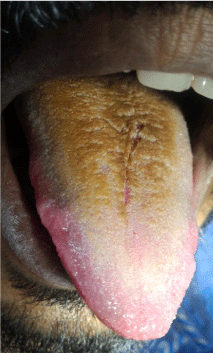Clinical Image
A 27 year old male patient visited the department of oral medicine and radiology with a chief complaint of a discolouration on the tongue surface since a month. Patient was medically fit. Personal revealed smoking cigarette about 3-4 per day since 10 years and paan chewing 2-3 per day since 5 years. Intraoral examination revealed presence of a brownish grey layer seen on the entire dorsal surface of the tongue on inspection. On palpation, it felt leathery, with multiple hairy extensions of the papillae which were non tender and non scrapable. A provisional diagnosis of hairy tongue was given. The patient was advised to maintain the oral hygiene by performing regular tongue scraping using a tongue cleaner.
Hairy tongue forms as a result of elongation of the filiform papillae over the dorsal surface of the tongue. Papillae are usually hardly keratinized due to which they are visible in pinkish white colour but since they tend to retains pigmentation from external sources, they therefore result in varying colours (eg: black, brown, white, green, pink). The tongue appears to have a thick coated surface in the middle. Bacterial and fungal overgrowth seems to also play a role in regards to the colour appearance of the tongue (Figure 1). In extreme cases, a blast of compressed air could show the papillae having a “waving in the breeze” kind of appearance [1-3].

Figure 1: Brownish white coating on the dorsal surface of the tongue.
References
- Shetty SM, Shetty R. Hairy Tongue (Linguavillosa Nigra): A case report. International Journal of Dental Clinics. 2011.
- Vano-Galvan S, Jaen P. Black hairy tongue. Cleve Clin J Med. 2008; 75: 847-848.
- Tamam L, Annagur BB. Black hairy tongue associated with olanzapine treatment: a case report. Mt Sinai J Med. 2006; 73: 891-894.
